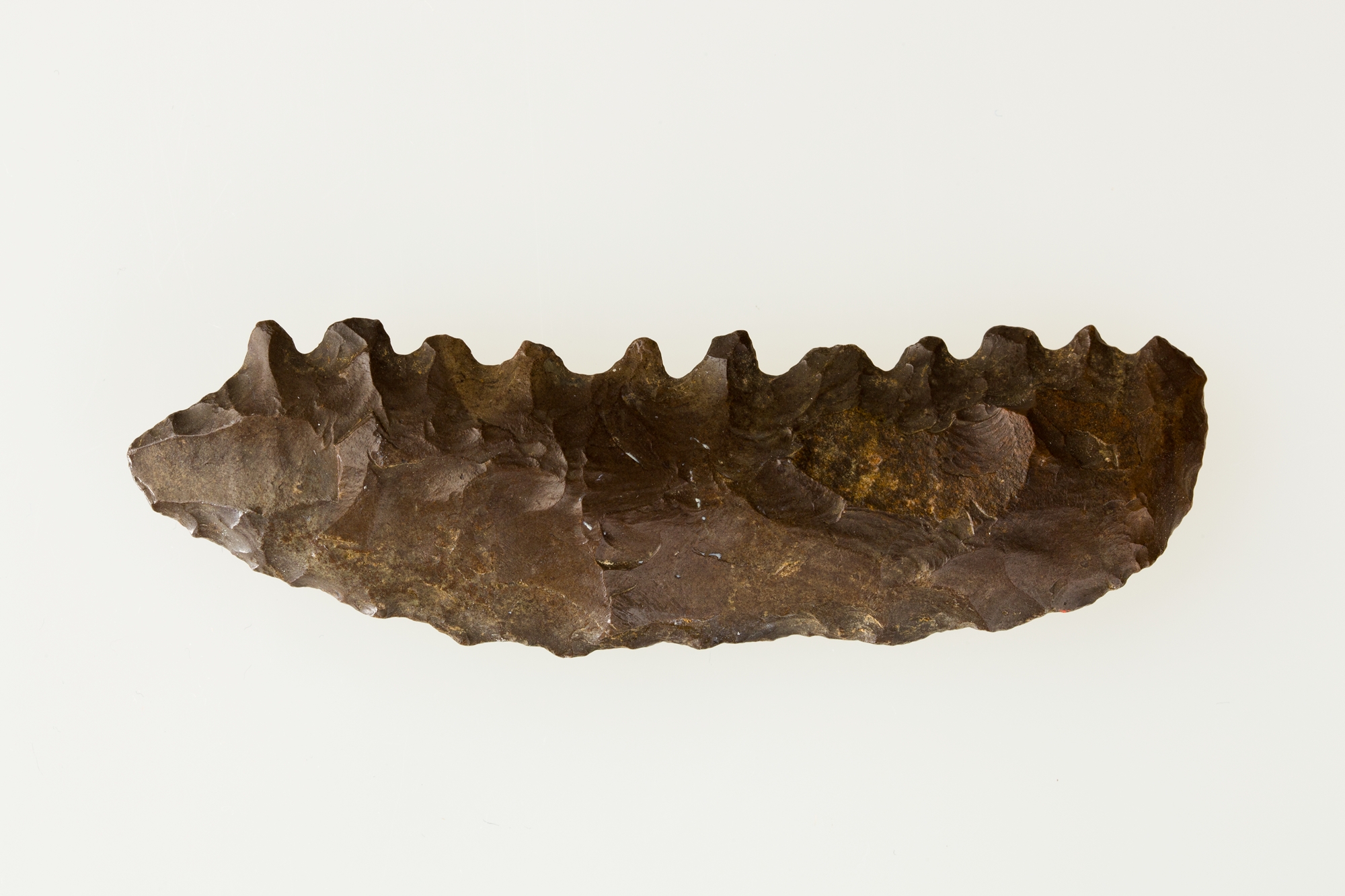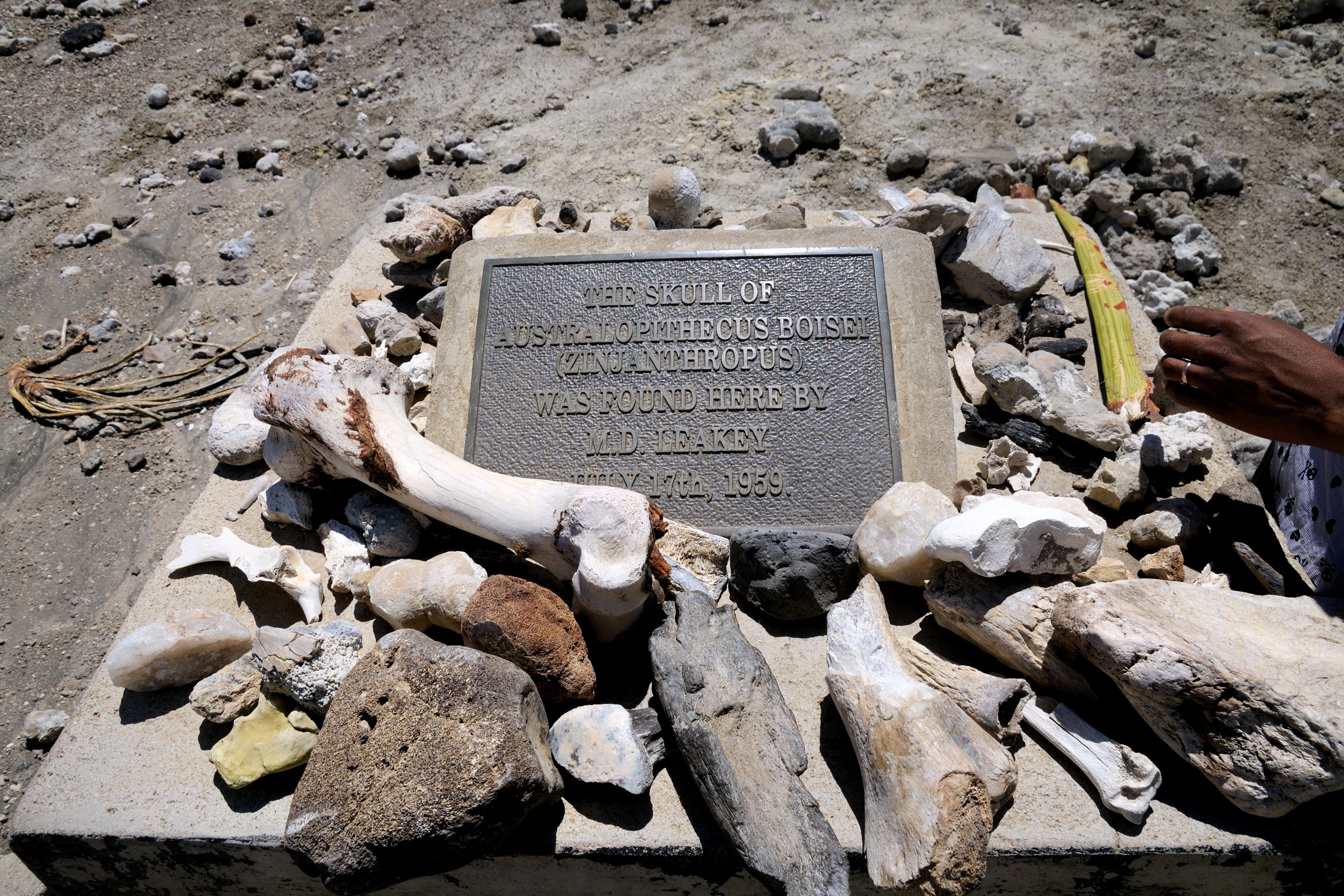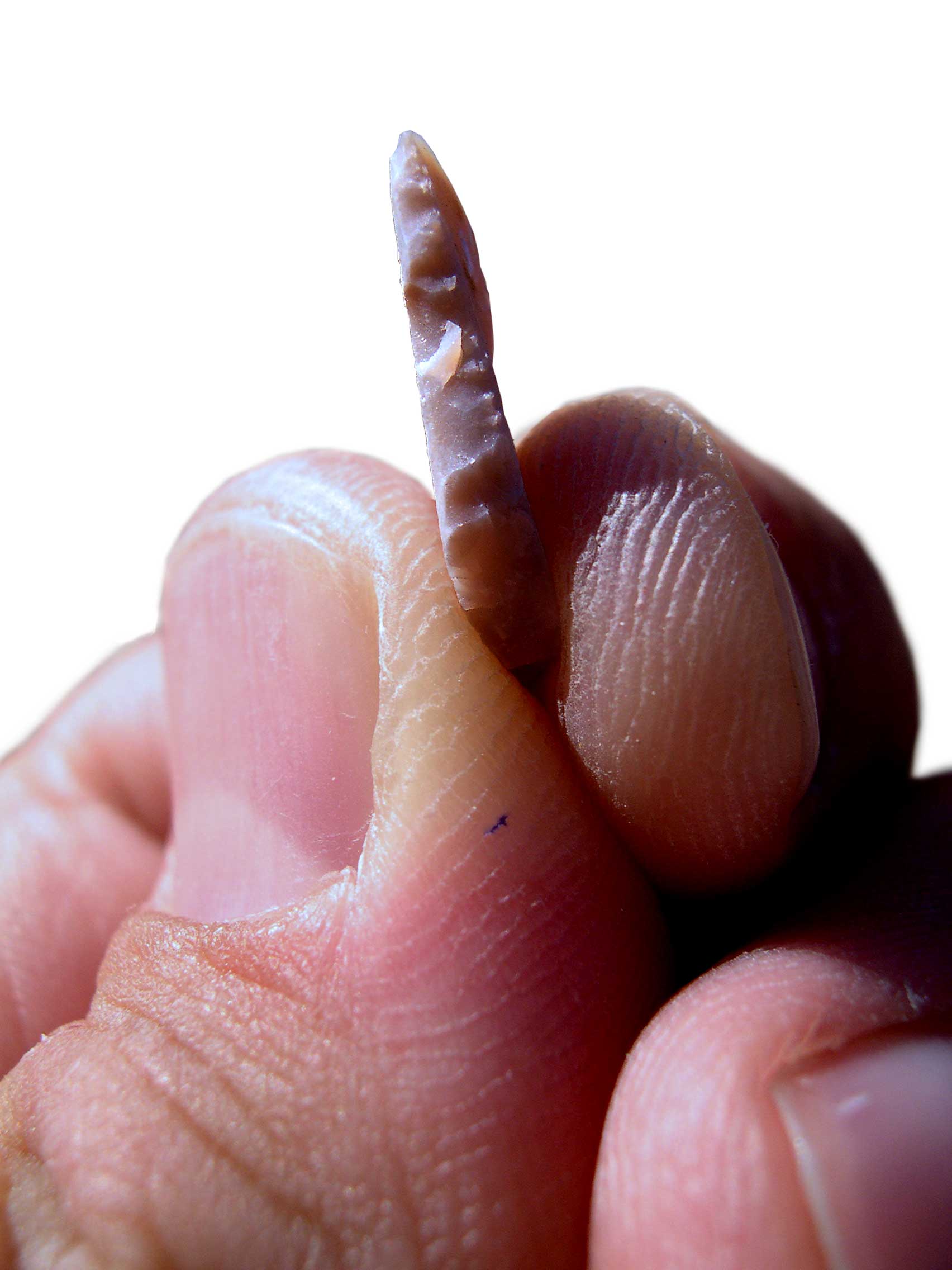|
Kom K And Kom W
Kom K and Kom W are Neolithic archaeological sites in the northern Fayum region of Egypt dating to the mid-5th millennium BCE with evidence of human occupation for approximately three centuries (4650-4350 BCE) from the stratified hearth mounds. Radiocarbon dates from charcoal and botanicals found beyond the mounds yield older yet scattered dates well into the 6th millennium BCE. Both sites are situated near the shores of Lake Qarun, which was extensively researched for its water level fluctuation, due to shifts in the Nile floods and its effect on human occupation periods. Kom K and Kom W were both situated within 1 km of the lake during most of its human occupation periods when lake levels were much higher. The first academic fieldwork was carried out by archaeologist Gertrude Caton-Thompson and geologist Elinor Wight Gardner in the three seasons of 1924-5, 1925-6, and 1927-8. Kom K and Kom W yielded archaeological findings that differ from the culture units within the Egyptian Ne ... [...More Info...] [...Related Items...] OR: [Wikipedia] [Google] [Baidu] |
Neolithic
The Neolithic period, or New Stone Age, is an Old World archaeological period and the final division of the Stone Age. It saw the Neolithic Revolution, a wide-ranging set of developments that appear to have arisen independently in several parts of the world. This "Neolithic package" included the introduction of farming, domestication of animals, and change from a hunter-gatherer lifestyle to one of settlement. It began about 12,000 years ago when farming appeared in the Epipalaeolithic Near East, and later in other parts of the world. The Neolithic lasted in the Near East until the transitional period of the Chalcolithic (Copper Age) from about 6,500 years ago (4500 BC), marked by the development of metallurgy, leading up to the Bronze Age and Iron Age. In other places the Neolithic followed the Mesolithic (Middle Stone Age) and then lasted until later. In Ancient Egypt, the Neolithic lasted until the Protodynastic period, 3150 BC.Karin Sowada and Peter Grave. Egypt in th ... [...More Info...] [...Related Items...] OR: [Wikipedia] [Google] [Baidu] |
Lacustrine
A lake is an area filled with water, localized in a basin, surrounded by land, and distinct from any river or other outlet that serves to feed or drain the lake. Lakes lie on land and are not part of the ocean, although, like the much larger oceans, they do form part of the Earth's water cycle. Lakes are distinct from lagoons, which are generally coastal parts of the ocean. Lakes are typically larger and deeper than ponds, which also lie on land, though there are no official or scientific definitions. Lakes can be contrasted with rivers or streams, which usually flow in a channel on land. Most lakes are fed and drained by rivers and streams. Natural lakes are generally found in mountainous areas, rift zones, and areas with ongoing glaciation. Other lakes are found in endorheic basins or along the courses of mature rivers, where a river channel has widened into a basin. Some parts of the world have many lakes formed by the chaotic drainage patterns left over from the last ice ... [...More Info...] [...Related Items...] OR: [Wikipedia] [Google] [Baidu] |
University Of Groningen
The University of Groningen (abbreviated as UG; nl, Rijksuniversiteit Groningen, abbreviated as RUG) is a Public university#Continental Europe, public research university of more than 30,000 students in the city of Groningen (city), Groningen in the Netherlands. Founded in 1614, the university is the second oldest in the country (after Leiden University, Leiden) and one of the most traditional and prestigious universities in the Netherlands. The institution has been consistently ranked among the top 100 universities in the world, according to leading ranking tables. In the 2022 Aggregate Ranking of Top Universities, RUG is ranked fourth in the Netherlands. The University of Groningen has eleven Faculty (division), faculties, nine graduate schools, 27 research centres and institutes, and more than 175-degree programmes. The university's alumni and faculty include Johann Bernoulli, Aletta Jacobs, four Nobel Prize winners, nine Spinoza Prize winners, one Stevin Prize winner, variou ... [...More Info...] [...Related Items...] OR: [Wikipedia] [Google] [Baidu] |
University Of California, Los Angeles
The University of California, Los Angeles (UCLA) is a public land-grant research university in Los Angeles, California. UCLA's academic roots were established in 1881 as a teachers college then known as the southern branch of the California State Normal School (now San José State University). This school was absorbed with the official founding of UCLA as the Southern Branch of the University of California in 1919, making it the second-oldest of the 10-campus University of California system (after UC Berkeley). UCLA offers 337 undergraduate and graduate degree programs in a wide range of disciplines, enrolling about 31,600 undergraduate and 14,300 graduate and professional students. UCLA received 174,914 undergraduate applications for Fall 2022, including transfers, making the school the most applied-to university in the United States. The university is organized into the College of Letters and Science and 12 professional schools. Six of the schools offer undergraduate degre ... [...More Info...] [...Related Items...] OR: [Wikipedia] [Google] [Baidu] |
Lithic Analysis
In archaeology, lithic analysis is the analysis of stone tools and other chipped stone artifacts using basic scientific techniques. At its most basic level, lithic analyses involve an analysis of the artifact’s morphology, the measurement of various physical attributes, and examining other visible features (such as noting the presence or absence of cortex, for example). The term 'lithic analysis' can technically refer to the study of any anthropogenic (human-created) stone, but in its usual sense it is applied to archaeological material that was produced through lithic reduction (knapping) or ground stone. A thorough understanding of the lithic reduction and ground stone processes, in combination with the use of statistics, can allow the analyst to draw conclusions concerning the type of lithic manufacturing techniques used at a prehistoric archaeological site. For example, they can make certain equation between each the factors of flake to predict original shape. These data ... [...More Info...] [...Related Items...] OR: [Wikipedia] [Google] [Baidu] |
Mary Leakey
Mary Douglas Leakey, FBA (née Nicol, 6 February 1913 – 9 December 1996) was a British paleoanthropologist who discovered the first fossilised ''Proconsul A proconsul was an official of ancient Rome who acted on behalf of a consul. A proconsul was typically a former consul. The term is also used in recent history for officials with delegated authority. In the Roman Republic, military command, or ...'' skull, an extinct ape which is now believed to be ancestral to humans. She also discovered the robust ''Zinjanthropus'' skull at Olduvai Gorge in Tanzania, eastern Africa. For much of her career she worked with her husband, Louis Leakey, at Olduvai Gorge, where they uncovered fossils of ancient hominines and the earliest hominins, as well as the stone tools produced by the latter group. Mary Leakey developed a system for Taxonomy (general), classifying the stone tools found at Olduvai. She discovered the Laetoli#Hominin footprints, Laetoli footprints, and at the Laetoli s ... [...More Info...] [...Related Items...] OR: [Wikipedia] [Google] [Baidu] |
Quern-stone
Quern-stones are stone tools for hand-grinding a wide variety of materials. They are used in pairs. The lower stationary stone of early examples is called a saddle quern, while the upper mobile stone is called a muller, rubber or handstone. The upper stone was moved in a back-and-forth motion across the saddle quern. Later querns are known as rotary querns. The central hole of a rotary quern is called the eye, and a dish in the upper surface is known as the hopper. A handle slot contained a handle which enabled the rotary quern to be rotated. They were first used in the Neolithic era to grind cereals into flour. Uses of quern-stones An old Gaelic proverb is "The quern performs best when the grindstone has been pitted." Design of quern-stones The upper stones were usually concave while the lower ones were convex. Quern-stones are frequently identifiable by their grooved working surfaces which enabled the movement of flour. Sometimes a millrind was present as a piece of wood (or o ... [...More Info...] [...Related Items...] OR: [Wikipedia] [Google] [Baidu] |
Microlith
A microlith is a small Rock (geology), stone tool usually made of flint or chert and typically a centimetre or so in length and half a centimetre wide. They were made by humans from around 35,000 to 3,000 years ago, across Europe, Africa, Asia and Australia. The microliths were used in spear points and arrowheads. Microliths are produced from either a small blade (Microblade technology, microblade) or a larger blade-like piece of flint by abrupt or truncated retouch (lithics), retouching, which leaves a very typical piece of waste, called a microburin. The microliths themselves are sufficiently worked so as to be distinguishable from workshop waste or accidents. Two families of microliths are usually defined: laminar and geometric. An assemblage of microliths can be used to date an archeological site. Laminar microliths are slightly larger, and are associated with the end of the Upper Paleolithic and the beginning of the Epipaleolithic era; geometric microliths are characteristic ... [...More Info...] [...Related Items...] OR: [Wikipedia] [Google] [Baidu] |
Scraper (archaeology)
In prehistoric archaeology, scrapers are unifacial tools thought to have been used for hideworking and woodworking. Many lithic analysts maintain that the only true scrapers are defined on the base of use-wear, and usually are those that were worked on the distal ends of blades—i.e., "end scrapers" (french: grattoir, link=no). Other scrapers include the so-called "side scrapers" or racloirs, which are made on the longest side of a flake, and notched scrapers, which have a cleft on either side that may have been used to attach them to something else. Scrapers are typically formed by chipping the end of a flake of stone in order to create one sharp side and to keep the rest of the sides dull to facilitate grasping it. Most scrapers are either circle or blade-like in shape. The working edges of scrapers tend to be convex, and many have trimmed and dulled lateral edges to facilitate hafting. One important variety of scraper is the thumbnail scraper, a scraper shaped much like ... [...More Info...] [...Related Items...] OR: [Wikipedia] [Google] [Baidu] |
Sickle
A sickle, bagging hook, reaping-hook or grasshook is a single-handed agricultural tool designed with variously curved blades and typically used for harvesting, or reaping, grain crops or cutting succulent forage chiefly for feeding livestock, either freshly cut or dried as hay. Falx was a synonym but was later used to mean any of a number of tools that had a curved blade that was sharp on the inside edge such as a scythe. Since the beginning of the Iron Age hundreds of region-specific variants of the sickle have evolved, initially of iron and later steel. This great diversity of sickle types across many cultures can be divided into smooth or serrated blades, both of which can be used for cutting either green grass or mature cereals using slightly different techniques. The serrated blade that originated in prehistoric sickles still dominates in the reaping of grain and is even found in modern grain-harvesting machines and in some kitchen knives. History Pre-Neolithic The d ... [...More Info...] [...Related Items...] OR: [Wikipedia] [Google] [Baidu] |
Projectile Point
In North American archaeological terminology, a projectile point is an object that was hafted to a weapon that was capable of being thrown or projected, such as a javelin, dart, or arrow. They are thus different from weapons presumed to have been kept in the hand, such as knives, spears, axes, hammers, and maces. Stone tools, including projectile points, can survive for long periods, were often lost or discarded, and are relatively plentiful, especially at archaeological sites. They provide useful clues to the human past, including prehistoric trade. A distinctive form of point, identified though lithic analysis of the way it was made, is often a key diagnostic factor in identifying an archaeological industry or culture. Scientific techniques exist to track the specific kinds of rock or minerals that were used to make stone tools in various regions back to their original sources. As well as stone, projectile points were also made of worked wood, bone, antler, horn, or ivory ... [...More Info...] [...Related Items...] OR: [Wikipedia] [Google] [Baidu] |
Adze
An adze (; alternative spelling: adz) is an ancient and versatile cutting tool similar to an axe but with the cutting edge perpendicular to the handle rather than parallel. Adzes have been used since the Stone Age. They are used for smoothing or carving wood in hand woodworking, and as a hoe for agriculture and horticulture. Two basic forms of an adze are the hand adze (short hoe)—a short-handled tool swung with one hand—and the foot adze (hoe)—a long-handled tool capable of powerful swings using both hands, the cutting edge usually striking at foot or shin level. A similar tool is called a mattock, which differs by having two blades, one perpendicular to the handle and one parallel. History Africa The adze is depicted in ancient Egyptian art from the Old Kingdom onward. Originally the adze blades were made of stone, but already in the Predynastic Period copper adzes had all but replaced those made of flint. stone blades were fastened to the handle by tying and early ... [...More Info...] [...Related Items...] OR: [Wikipedia] [Google] [Baidu] |



.jpg)


_1934.jpg)


.jpg)

.png)